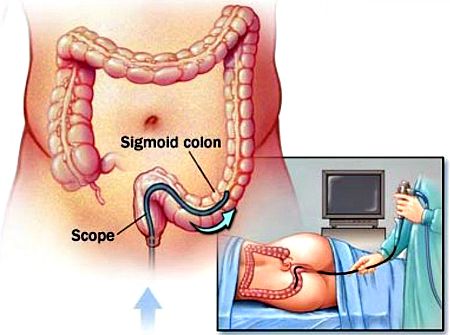Flexible Sigmoidoscopy: Overview, Indications, Procedure
Flexible sigmoidoscopy is a colorectal cancer screening technique that detects 50% to 60% of colon cancers. With flexible sigmoidoscopy, the inner lining of the rectum and the last 2 feet of the distal colon can be visualized; 60-cm sigmoidoscopy is preferred.
INDICATIONS
● Rectal bleeding
● Positive Hemoccult test
● Mass on digital examination
● Lower abdominal pain and cramping
● Change in bowel habits
● Foreign body in the rectum
● Itching—anal or perianal
● Pain—anal or perianal
CONTRAINDICATIONS
● Acute abdomen
● Diverticulitis
● Cardiovascular or pulmonary disease
● Ileus
● Suspected perforation
● Megacolon
● Pregnancy
● Recent pelvic or abdominal surgery
● Coagulation disorders
CLICK HERE for Free NCLEX –RN & CGFNS Practice Questions
PROCEDURE
Flexible Sigmoidoscopy
Equipment
● Flexible sigmoidoscope—60 cm (Fig. 113.1)
● Light source
● Two pairs of gloves—nonsterile
● Suction
● K-Y jelly or 2% lidocaine jelly
● 4 × 4 gauze—nonsterile
● Absorbent pads—nonsterile
● Drape—nonsterile
● Culture tubes
● Emesis basin
● Sigmoidoscopy report sheet
Procedure
● Position the client in the left lateral decubitus position.
● Right leg flexed at the hip and knee
● Put on two pairs of gloves.
● Lubricate the second or third digit of the dominant hand.
● Perform a digital examination to dilate the sphincter.
● Lubricate the anus and the tip of the sigmoidoscope.
● Lubricate the distal half of the sigmoidoscope but not the lens.
● Remove the top pair of gloves and dispose of them.
● Separate the gluteal folds.
● Insert the scope gently 8 to 10 cm.
● Activate the light, suction, and air.
● With the right hand—Advance the scope.
● With the left hand—Work the controls on the scope.
● Open the colon by insufflating with a small amount of air, and advance the scope gently.
● Do not use too much air—this causes discomfort.
● Advance the scope using one of the following techniques
● Hook and pullout—used to straighten the colon
• Hook mucosal fold, and pull back to straighten the colon.
● Dither and torque—used to shorten the colon
• Alternate insertion with slow partial withdrawal to pleat the colon.
• Twist the sigmoid shaft clockwise or counterclockwise with a forward and/or backward motion.
• Observe for natural landmarks and abnormalities.
● Take a biopsy specimen of all abnormal areas and put in culture tube for biopsy.
● Withdraw the sigmoidoscope slowly, reinspecting the mucosa.
● When in the rectal vault, retroflex the tip of the scope to visualize the distal rectum.
● Straighten the tip, and gently withdraw the scope.
● Cleanse, sterilize, and store per manufacturer’s instructions.
CLICK HERE for Free Nursing Care Plans
Client Instructions
● The following may be expected but will resolve quickly.
● Abdominal cramping if a biopsy specimen was obtained
● Feeling of fullness, distention, or flatus
● No bowel movement for several days
● Minor bleeding
● No special diet is recommended after the procedure.
● Watch for signs of infections, such as
● Elevated temperature
● Increased or prolonged rectal pain
● Green or yellow drainage
BIBLIOGRAPHY
Colodny CS. Procedures for your practice. Patient Care, April 1996:151–157.
Dominitz JA, McCormick LH, Rex DK. Latest approaches to prevention and screening.
Patient Care, April 1996:124–142.
National Cancer Institute. Fact Sheet—Tests to Detect Colorectal Cancer and Polyps. Date
unknown. http://www.cancer.gov/cancertopics/factsheet/detection/colorectal-screening.
Reilly HF. Primary care use of the flexible sigmoidoscope to detect colorectal cancer and its
precursors. Primary Care Cancer, 1994;14(5):41–45.
Flexible sigmoidoscopy. YouTube.
CLICK HERE for more resources on Laboratory & Diagnostic Test

